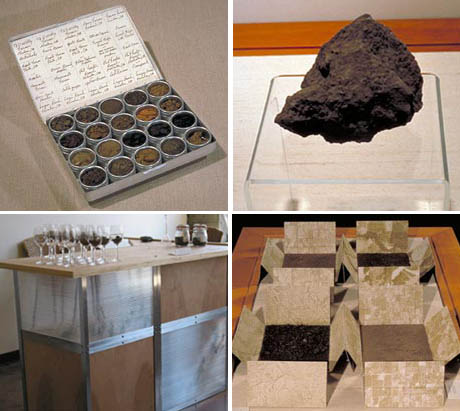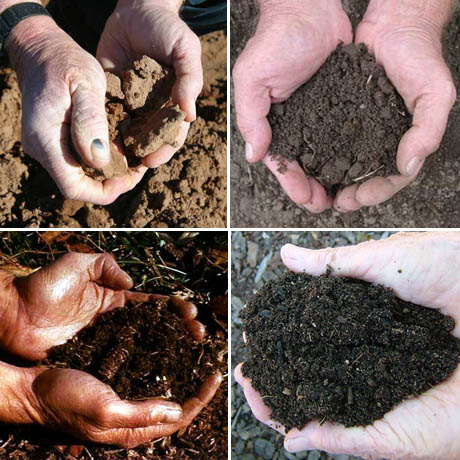
IMAGE: From “Soil: A Series,” 2001, by Laura Parker: “Palette,” “Clod,” “Soil Bar,” and “Soil Survey Books.”
“It used to be,” writes William Bryant Logan in Dirt, “that a good farmer could tell a lot about his soil by rolling a lump of it around in his mouth.” Today, apparently, it is harder to find someone who literally eats dirt:
Not in Texas, nor Vermont, nor Kentucky, nor California, nor western New York. Everybody knew somebody who once did it, but nobody could quite remember the name of the fellow.
Finally, Logan came across Bill Wolf, an organic pioneer who started his environmental research under Buckminster Fuller and who used to eat soil, until his doctor forbade him.
Soil contains bad bugs as well as good ones, and the physician did not want to have to sort them out in Wolf’s guts. But back in the days when he chawed, Bill could tell acid from alkaline by the fizz of the soil in his mouth.
A very acid soil would crackle like those sour candies that kids eat, and it had the sharp taste of a citrus drink. A neutral soil didn’t fizz and it had the odour and flavour of the soil’s humus, caused by little creatures called “actinomycetes.” An alkaline soil tasted chalky and coated the tongue.
Having conducted this simple taste test, Logan explains, farmers could apply calcium carbonate to the Sprite-flavoured fizzy soil and gypsum to the Milk of Magnesia tongue-coating soil, which would then “react with the hydrogen of acid clays and the sodium of salt-clays, respectively,” in order to re-balance the soil’s pH and improve its structure.
However, our taste buds can only detect five basic flavours: sweet, salty, sour, bitter, and umami. In fact, three-quarters of everything we describe as flavour is actually smell – which helps explain why artist Laura Parker’s soil-tasting sessions do not actually involve eating dirt.
Her “A Taste of Place” events (the next is on December 10, in Santa Rosa, California) are designed to connect the smell of the earth to the flavour of foods grown in it. Participants can expect to sample two or three wine glasses, each filled with soil from a different organic farm:
First the scent of the soil will be stimulated by adding a small amount of water and stirring to release the earth’s aromas as if from a fresh rain. Then you will smell, identify the scents you recognize, and note their properties. You will then be served food grown in the same soil you have just smelled. See if you can taste in the food the same properties you smelled in the soil. Please note your reactions and experiences.
By way of example, Parker shares some of her own tasting notes for soil, which draw heavily on the vocabulary of wine appreciation. Soil from Philo Apple Farm, located on California’s Navarro River flood plain, is described as “a bit less exotic in aroma, but more varietal, with olive and mineral notes, and a bit weightier finish. The nose here is clay and smoky with huge extract and extraordinary elegance.”
Meanwhile, nearly 300 miles south, earth from T & D Willey Farms in the San Joaquin Valley has a “subtle yet complex nose, grassy and vegetative,” while its “underlying presence of cream opens up to hints of citrus and spice.”

A soil’s unique characteristics, Parker suggests, can also be tasted in the food grown in or on it. In other words, if the earth on which your farm sits has “grassy,” “olive,” or “smoky” notes, those flavours will recur in the organic spinach or goat’s milk cheese you produce. Smelling the soil first simply helps you become aware of the continuity. Recent participant Anne Zimmerman described her tasting experience thus:
The mud from Pugs Leap Farm in Healdsburg was thick and dark and hearty, and smelled like a green pasture. After smelling the soil, we tasted chervil grown at Pugs Leap, then a chunk of egg from chickens raised at Pugs Leap, and finally a delicate slice of tomme cheese made from the milk of goats raised at Pugs Leap. […]
The chervil was delicate yet distinctly herbaceous, and the yolk of the egg had a creamy green freshness. And the tomme was soft, mild, and — can I say it again? — divinely green.
At least in my experience, taste is highly suggestible: tell me that the Chardonnay has a vanilla base note, and it undoubtedly will. Nonetheless, accompanying vegetables with a tasting glass of the soil they were grown in makes a powerful sensory connection between landscape and food – a literal appreciation of terroir.

Another amazing post – very interesting, and, above all, inspiring! I intend to have a soil-smelling/food tasting with my next locally-grown dinner. Thanks!
My grandfather (Swedish immigrant living in Minnesota) tried to instill in me an appreciation of that art when I was a child. I think it was common knowledge among farmers in that era (early to mid 20th century).
Sadly, many people in Haiti must resort to eating soil. There some people subsist on cookies made of clay.
I am a soil scientist and thus study soils for a career. Tasting soil sometimes happens–on rare and unhindered occasions. Though, there are many other less health hazardous ways to identify the characteristics of soil. Knowing the complexity of bacterial and fungal life that exists in the depths, I would never recommend anyone doing this regularly.
There are still many places in the world where eating soil is part of a daily diet–after all, it is where the vast majority of nutrients that sustain plants comes from. I don’t believe they are eating it for its nutty overtones though.
I must admit I’ve never considered eating dirt, but I may begin smelling it. It is an interesting approach for gaining a better understanding of the terra firma beneath our feet. Thanks for the post.
cool! thanks for the inspiration.